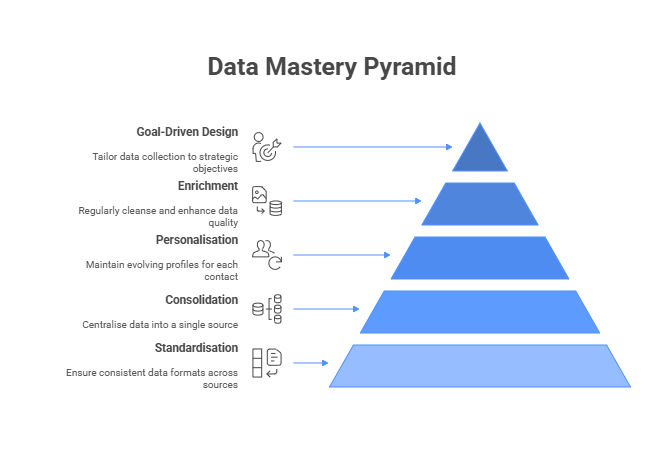
Let’s face it — event data can feel messy, frustrating, and often like a task best left for “someone more technical.” But here’s the thing: data is one of the most valuable tools you have as an event marketer or organiser. Whether you’re running a B2B trade show or niche conference, knowing how to work with your data instead of just collecting it can be the difference between flatlining and fast growth.
This guide is for those of you who are using event data in a basic way — perhaps pulling attendee lists into Excel or glancing at open rates — but want to truly master it. You don’t need to become a data scientist. But you do need to understand what great data looks like, and how to build habits and systems that treat it with the respect it deserves.
Here’s how to go from data beginner to data master, step by step.
Step 1: Standardise or suffer
Beginner issue: You’re getting data from different places — registration forms, ticketing platforms, spreadsheets from partners — and none of it lines up neatly.
Master mindset: Every data point must follow a shared standard.
That means:
-
Decide on a single format for things like job titles, company names, and sectors.
-
Use dropdowns instead of free-text where you can.
-
Make sure fields are consistent across all sources: “Email” should be “email” everywhere, not “e-mail”, “Email Address”, or “@”.
This is the first and easiest thing you can do to save yourself hours later. Without standardisation, every data task becomes a clean-up operation.
Step 2: Consolidate your chaos
Beginner issue: Your data is scattered across five platforms and a dozen spreadsheets.
Master mindset: Build one source of truth.
This means pulling everything together into one central database or CRM. Whether you’re using HubSpot, Salesforce, or even a well-organised spreadsheet (to start), your aim is the same: no duplication, no versioning headaches, no data silos.
When all your data lives in one home, you can actually see the full picture, not just fragments.
Step 3: Keep a single, evolving record per person
Beginner issue: You’ve got multiple versions of the same person across different shows and years.
Master mindset: Build a living, breathing profile for each contact.
This is crucial. Jane Smith from ABC Ltd shouldn’t exist five times in your database. She should exist once, with a rich record that tells you:
-
Which events she’s attended
-
What her job role was when she registered
-
How she engaged with your emails
-
What products or topics she’s shown interest in
This makes personalisation effortless and ensures you’re not treating returning attendees like strangers.
Step 4: Cleanse and enrich — regularly
Beginner issue: You’re relying on stale, half-complete info.
Master mindset: Make data hygiene a habit, not a project.
At least once a year (ideally more), give your data a proper wash:
-
Remove duplicates
-
Fix formatting issues
-
Fill in missing fields (especially job title, industry, company size, etc.)
-
Validate emails, phone numbers, and postal addresses
Then go a step further. Use third-party enrichment to add valuable layers: social handles, company insights, decision-making role — this transforms data from functional to powerful.
Step 5: Build data that fits your goals, not just your forms
Beginner issue: You’re collecting data just because the form builder had the field.
Master mindset: Be intentional. Build data for growth.
This is where you really start becoming an elite operator.
Ask:
-
What segmentation do I wish I had?
-
Which types of leads are my exhibitors asking for?
-
What insights could drive better matchmaking or more relevant content?
Then work backwards. Add fields to your registration forms and surveys that feed these goals. Don’t ask 20 questions for the sake of it — ask the right five.
You can even test different field sets across shows, or personalise the journey based on the registrant’s profile. This is how you go from gathering data to designing it.
The Bonus Level: Treat Data Like a Product
When you reach this stage, your event data isn’t just an admin task or a list of contacts. It’s an asset — a strategic product that improves with every show you run.
You start using it to:
-
Create ultra-targeted visitor campaigns
-
Sell smarter exhibitor packages
-
Launch new shows with built-in demand signals
-
Track lifetime value and behaviour trends
That’s what data mastery looks like. And it’s closer than you think.
Final Thought
Mastering event data doesn’t mean becoming a tech whiz. It means building habits and systems that put quality, clarity, and strategy at the heart of how you collect and use information.
Start small: standardise, consolidate, clean. Then build up from there. And if it feels overwhelming? Remember — most of your competitors aren’t even close to doing this properly. So if you do, you’ll be miles ahead. For our bespoke consultation services on how to master your event data, get in touch.